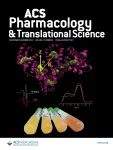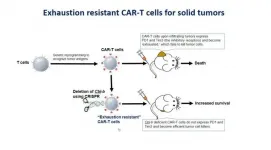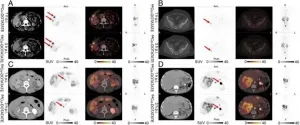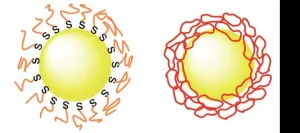Researchers develop a new approach to detect pancreatic cancer
2021-01-21
(Press-News.org) A protein found commonly in human blood might help with the detection of hard-to-diagnose pancreatic tumours. Researchers at Martin Luther University Halle-Wittenberg (MLU), the Alfried Krupp Hospital in Essen and the University of Witten/Herdecke have developed approach using the protein's structure and its function as a proxy for this. In a first study in ACS Pharmacology & Translational Science, the team shows how its method can also be used to differentiate between benign and malignant tumours.
Pancreatic cancer is particularly insidious: "It remains asymptomatic for a long time, which leads to very late diagnoses and therefore a low chance of treating it successfully," says Dr Marcos Gelos from the Alfried Krupp Hospital and Witten/Herdecke University who headed up the new study together with Professor Dariush Hinderberger, a chemist at MLU. Nine out of ten patients succumb to the disease within five years after being initially diagnosed. At the same time, it is very difficult to distinguish between benign and malignant pancreatic tumours. The only utilisable lab test is inconclusive as it can also be an indication, for example, of a chronically inflamed pancreas, says Gelos. Even imaging techniques and tissue analyses often do not provide a clear differentiation between benign and malignant tumours to be made.
Because of that, Gelos and Hinderberger looked for a biomarker in human blood that could act as a kind of early warning system. "The molecule would need to be very prevalent in the body and should not originate directly from the tumour, because otherwise it would be spotted too late," says Hinderberger. They chose the protein albumin, which occurs in large quantities in the blood. Different tumours are known to alter the way it functions in the body in different ways. One of albumin's jobs is to transport fatty acids into the cells. Since a protein's spatial structure determines the way it works, the researchers hypothesised that it should be possible to detect small structural changes in the protein in ill patients.
Using electron spin resonance spectroscopy (EPR), the chemists at MLU examined the blood serum of people with a benign or malignant pancreatic tumour and, for comparison, also samples from healthy people. Nearly 80 samples were analysed. Instead of conducting a complete structural analysis of the protein, the team at MLU examined the protein's ability to bind said fatty acids. Regular albumin is known to be able to bind seven fatty acids at precisely defined points. "In the lab we use special fatty acids modified with probes whose movement could be traced using EPR. We then added these fatty acids in different concentrations to the patient serum including the albumin," explains Hinderberger. This enabled the researchers to reconstruct how many fatty acids bound to the albumin at which specific sites, identify what the environment directly around the binding sites was like, and determine the distances between the fatty acids. "With this approach we were able to generate a very precise picture of the spatial structure and dynamics of the protein at work," says Hinderberger.
In fact, the scientists were able to identify specific differences between the individual patient groups starting at a certain proportion of fatty acids: The spacing patterns and the local environment of the fatty acids were somewhat different in the patients with cancer than in those with a benign tumour as well as in the healthy patients. "The structural changes were minute. However, the differences are large enough to distinguish between the different samples, in other words, to establish whether it is a benign or a malignant tumour," Hinderberger concludes. The underlying mechanism how the tumour changes the structure of albumin remains elusive.
As of now, the study by the researchers from Halle and Essen is still only a promising approach and it will be years or decades before it can be used in a clinical setting. Before this can happen, the method needs to be tested on significantly larger samples and they will need to be refined further. For Gelos, the approach shows a lot of potential: "If this method enables us to distinguish between benign tumours and malignant cancers, that would be great."
INFORMATION:
Study: Haeri H. et al. Identification of Patients with Pancreatic Cancer by Electron Paramagnetic Resonance Spectroscopy of Fatty Acid Binding to Human Serum Albumin. ACS Pharmacology & Translational Science (2020). Doi: https://pubs.acs.org/doi/full/10.1021/acsptsci.0c00116
[Attachments] See images for this press release:

ELSE PRESS RELEASES FROM THIS DATE:
2021-01-21
DALLAS - Jan. 19, 2021 - Eliminating a single gene can turn exhausted cancer-fighting immune cells known as CD8+ T cells back into refreshed soldiers that can continue to battle malignant tumors, a new study led by UT Southwestern researchers suggests. The findings, published online this week in the Journal for Immunotherapy of Cancer, could offer a new way to harness the body's immune system to attack cancers.
In 2017, the Food and Drug Administration approved treatments involving chimeric antigen receptor T (CAR-T) cells, which consist of immune cells known as T cells that ...
2021-01-21
Reston, Virginia--The imaging time window of 64Cu-DOTATATE positron emission tomography/computed tomography (PET/CT) for patients with neuroendocrine neoplasms can be expanded from one hour to three hours post-injection, according to new research published in the January issue of the Journal of Nuclear Medicine. In a head-to-head comparison of scans performed at the two time intervals, there were no significant differences in the number of lesions detected, and tumor-to-normal tissue ratios remained high in all key organs.
Previous research has demonstrated that 64Cu-DOTATATE PET imaging at one hour post-injection provides excellent lesion detection in patients with neuroendocrine neoplasms. "Given the long half-life and excellent image resolution of 64Cu-DOTATATE, ...
2021-01-21
Successful weight loss is considered to be an integral part of the therapy for type 2 diabetes. Nevertheless, studies keep appearing that question the importance of losing weight. However, new data from a large-scale observational study carried out at DIfE in cooperation with the German Center for Diabetes Research (DZD) support the current recommendations of physicians. The findings, published in the journal Diabetologia, suggest that obesity and weight gain can lead to vascular disorders, the leading cause of disease and death for people with type 2 diabetes.
A close look at vascular disorders
Weight plays a crucial role in the development of type 2 diabetes. However, ...
2021-01-21
Chemical engineers at UNSW Sydney have found a way to make 'green' ammonia from air, water and renewable electricity that does not require the high temperatures, high pressure and huge infrastructure currently needed to produce this essential compound.
And the new production method - demonstrated in a laboratory-based proof of concept - also has the potential to play a role in the global transition towards a hydrogen economy, where ammonia is increasingly seen as a solution to the problem of storing and transporting hydrogen energy.
In a paper published today in Energy and Environmental Science, the authors from UNSW and University of Sydney say that ammonia synthesis was one of the critical achievements of the 20th century. When used in fertilisers ...
2021-01-21
It takes a lot to make a wooden table. Grow a tree, cut it down, transport it, mill it ... you get the point. It's a decades-long process. Luis Fernando Velásquez-García suggests a simpler solution: "If you want a table, then you should just grow a table."
Researchers in Velásquez-García's group have proposed a way to grow certain plant tissues, such as wood and fiber, in a lab. Still in its early stages, the idea is akin in some ways to cultured meat -- an opportunity to streamline the production of biomaterials. The team demonstrated the concept by growing structures made of wood-like cells from an initial sample of cells extracted from zinnia leaves.
While that's still ...
2021-01-21
Hokkaido University scientists have found a way to prevent gold nanoparticles from clumping, which could help towards their use as an anti-cancer therapy.
Attaching ring-shaped synthetic compounds to gold nanoparticles helps them retain their essential light-absorbing properties, Hokkaido University researchers report in the journal Nature Communications.
Metal nanoparticles have unique light-absorbing properties, making them interesting for a wide range of optical, electronic and biomedical applications. For example, if delivered to a tumour, they could react with applied light to kill cancerous tissue. A problem with this approach, though, is that they easily clump together in solution, losing their ability to absorb light. ...
2021-01-21
Thirty-five people have died in the custody of U.S. Immigration and Customs Enforcement (ICE) since April 2018, with a seven-fold increase in deaths even as the average daily population decreased by nearly a third between 2019 and 2020, a new USC study shows.
"Potentially preventable causes of death -- including COVID-19 infection, influenza and suicide -- are responsible for at least half of recent deaths," said researcher Sophie Terp, an assistant professor of clinical emergency medicine at the Keck School of Medicine of USC and a clinical scholar at the USC Schaeffer Center for Health Policy and ...
2021-01-21
Research from the University of Adelaide has found that some species of fish will have higher reproductive capacity because of larger sex organs, under the more acidic oceans of the future.
Published in PLOS Biology, the researchers say that far from the negative effects expected under the elevated CO2 levels in our oceans predicted for the end of the century, these fish capitalise on changes to the underwater ecosystems to produce more sperm and eggs. They also look after them better, enhancing the chances of reproductive success.
"The warming oceans absorb about one-third of the additional CO2 being released into the atmosphere from carbon emissions, causing the oceans to acidify," says lead author Professor Ivan Nagelkerken from the University's Environment ...
2021-01-21
Dendritic cells are a vital component of the innate immune system, which constitutes the body's first line of defense against infectious agents and tumor cells. Their job is to activate the T-cell arm of the adaptive immune system, which confers specific and long-lasting protection against bacterial and viral infections. Dendritic cells engulf and degrade proteins that signal the presence of invasive pathogens. The resulting fragments (antigens) are displayed on their surfaces. T cells bearing the appropriate receptors are then activated to seek out and eliminate the pathogen. Newborns and young children ...
2021-01-21
Packing a lunchbox with fruit, sandwiches, and snacks is common practice for most Australian families. But what if there was another way?
Flinders University researchers investigating the pros and cons of school-provided lunches say uniform delivery of lunchtime food at school could be a solution to better childhood nutrition and learning in Australia.
Flinders Caring Futures Institute deputy director Professor Rebecca Golley says universal school-provided lunch models - a common practice in other countries such as the UK - would involve all children in the ...
LAST 30 PRESS RELEASES:
[Press-News.org] Researchers develop a new approach to detect pancreatic cancer






